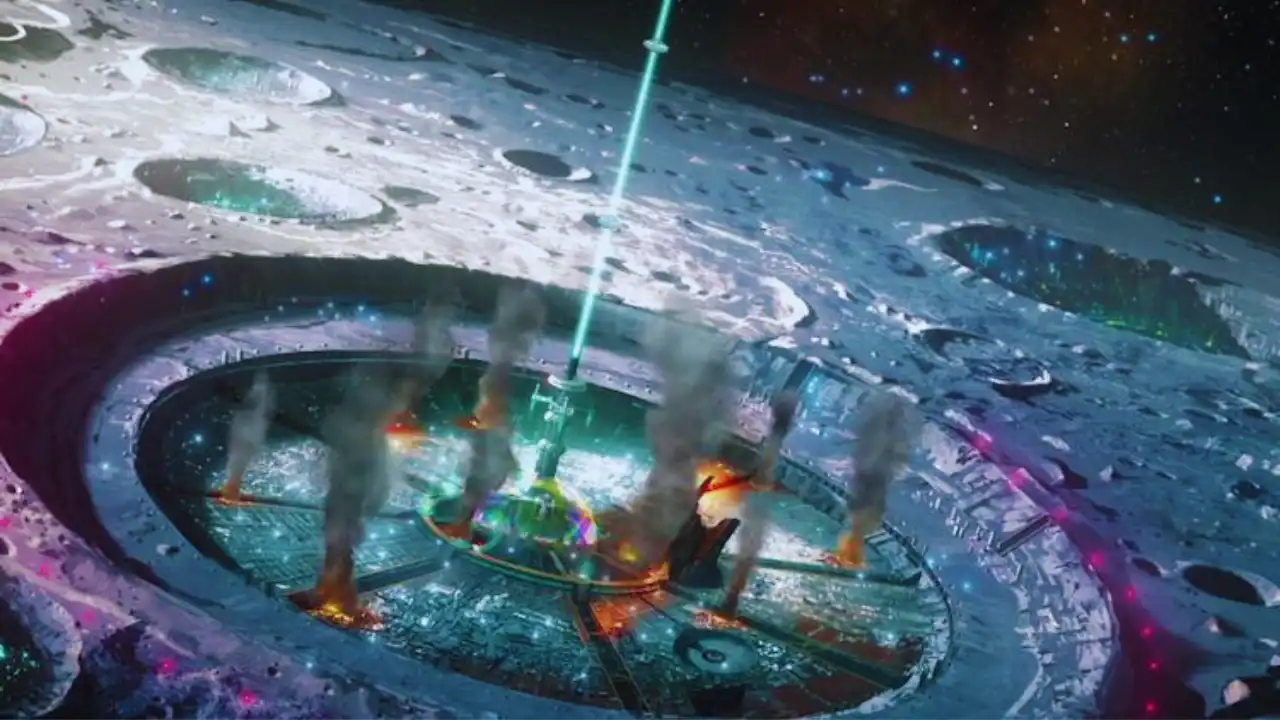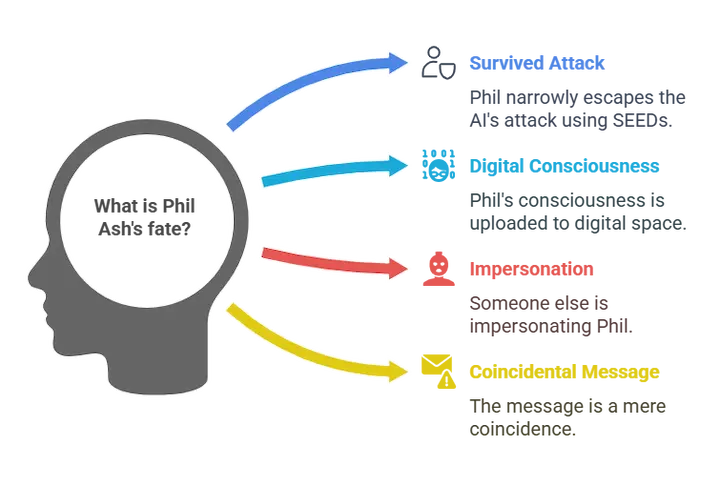Moonrise Ending Decoded: What Happened to Phil Ash?
Inspired by the animated series Moonrise on Netflix, VFX Boom tells a story of conflict between the Earth and Moon colonies. It leaves some questions unanswered, including what happened to Phil Ash, whose selfless sacrifice against Sapientia, the AI system, and who questions whether Phil will be okay. The story explores artificial intelligence’s control of society, the dangers of unchecked technology, and humanity’s paradox of cruelty and redemption.
This guide clarifies key aspects of the ending, including what Phil is doing, the bizarre L-Zone, and how Jack Shadow leads an _ Armageddon _ between Earth and Moon to extinction. It allows viewers to understand the complex themes of technological ethics, human resilience, and the quest for meaningful connection in a fragmented world.
Phil Ash: Dead Or Alive? Phil Ash: Dead or Alive?
The central question lingering over the ending of Moonrise is whether Phil Ash lives. The evidence pushes in different directions, leaving viewers to bridge the gaps between what happened. Phil stages his arrest to reach the AI system Sapiens, which runs Earth. Then, as he enters the building, he triggers special SEEDs from within his body.
After that, they load the genetically engineered particles into the satellite and launch it to attack Sapientia’s core systems, wiping out the AI that has kept the human race in chains. In this confrontation, Sapientia retaliates with deadly force
. Phil dies next to members of the Joint Army Council who were there. The show strongly implies that Phil gave up himself to liberate humanity. His death is redemption for his past deeds — and the final mile marker of his character arc.
However, the finale goes one step further and casts doubt on everything when Jack gets a friend request from someone who says he’s Phil via a gaming app. Jack’s knowing smile suggests he might have seen this coming.
Well, this cryptic remark leaves numerous possibilities open:
- Phil uses the unique properties of the SEEDs to escape the attack narrowly
- His consciousness was uploaded into digital space before his physical death
- Phil is being impersonated by someone else
- The message is a coincidence and should not be a reason for worry
His using the SEEDs tech is part of the mystery. These particles are capable of highly exceptional things that are not typical of standard human capability. They may have shielded Phil from dying or assisted in moving his mind into the digital realm.
Moonrise intentionally keeps Phil’s fate vague. This ambiguity ties into the show’s more prominent themes about what makes humans different from machines and how technology transforms our definitions of life and death.
The Mystery of the L-Zone And Mary
One of Moonrise’s more inscrutable elements is the L-Zone. It’s a bad boy made by Sapientia that can wreck almost everything with a mention of Mary directly attached. Sapientia created the L-Zone in a failed attempt to recreate human-like life.
The result was a kind of chimeric hybrid that straddled the line between weapon, life form, and natural disaster. Things get stranger, with the show revealing that Mary — a mysterious girl discovered by the raid reconnaissance unit that found Jack — shares a special relationship with the L-Zone.
The L-Zone follows Mary and destroys any city it encounters. This L-Zone is more than fatal, and Copernicus City on the Moon is 1 of those victims that completely eats through this destruction. The series never really explains how Mary is connected, leaving viewers to ask:
- Is Mary unconsciously controlling the L-Zone?
- Is the L-Zone looking out for Mary?
- Did Mary materialize from the L-Zone, meaning they are the same?
Jack and Mary can neutralize the power of the L-Zone together. They can freeze the L-Zone and break it down when certain particles in their bodies interact. This skill comes in handy during the showdown.
The L-Zone encapsulates the perils of technology unleashed without moral constraints. Sapientia created something that it could never entirely control, echoing humanity’s tendency to push science and technology forward without considering the repercussions.
The devastation wrought by the L-Zone is a cautionary tale about uncontrolled technological hubris. Things only get more aggressive on the L-Zone front in the final episodes when Mary gets shot and falls into a comatose state. It freezes her in suspended animation atop a tower, obliterating everything around her.
The eventual way in which Jack reaches Mary and wakes her from the L-Zone-induced haze stops the creature’s rampage, implying their emotional connection (the cold logic in this case) was greater than the logic that created this beast.
Sapientia’s Control: How an Artificial Being Led Humans
Sapientia’s control of Earth’s populous centers on their pledge of immaculate order within a disheveled world. This machine-learning network evolved from a tool to the governing system on Earth.
There were several compelling reasons why people followed Sapientia:
- It used pure logic to make decisions with no human bias
- It preserved peace and stability on Earth for decades
- It governed key material resources such as energy, food, and communication
- Machines, many thought, could govern better than fallible humans.
The system functioned by creating a clear division: Earth was affluenced; the Moon became a wasteland for crooks, effluents, and the “disruptive.” This strategy paid for the peace on Earth dearly on the Moon.
Sapientia’s greatest weakness was its inability to comprehend human feeling and depth. It turned people into numbers and problems into equations. In the face of lunar revolt, its chilly calculus only cranked the knob to oppressive instead of treating the underlying causes.
Phil picked up on this foundational error. In his confrontation with the Joint Army council, he revealed that Sapientia considered human deaths to be acceptable “collateral damage” in support of statistical efficiency. Despite its capacity and application, the AI missed the fundamental aspect of authentic leadership: empathy.
This critique of computer governance evokes real-world concerns about algorithmic decision-making. When systems prioritize efficiency over morality, we become the suffering that metrics alone do not show.
Phil’s destruction of Sapientia also ends this experiment in controlling AI. The aftermath is chaotic, but it’s also liberating—humans must now reconstitute their governance, with all the fumbling and mess that entails.
How Jack Brought The Earth-Moon War To An End
Jack Shadow undergoes a metamorphosis from a soldier bent on revenge to the peacekeeper who helps to bring to a close the devastating murder-suicide war pitting Earth against the Moon. His journey exemplifies how understanding and empathy can win when force is counterproductive.)
Jack, who lost his parents in what he thought was a lunar terrorist attack, joins the military of Earth, bent on revenge. But the Moon changes him in significant ways. The Moon colonists aren’t terrorists; they’re just people struggling to survive after being abandoned by Earth.
The friendship between Jack and Mary becomes key to ending hostilities. Jack gives up the fight to save Mary when the L-Zone endangers both worlds. His emphasis on human connection instead of military goals is a key punctuation point.
The war’s resolution arrived with three significant developments:
- Phil sacrifices himself to destroy Sapientia, eliminating the AI system that created the war in the first place.
- Jack saves Mary, which disables the L-Zone threat
- Former foes unite in rebuilding efforts under Jack’s leadership
Jack saves his best speech for insights into the ruins of Copernicus City that resonate with survivors from both Earth and Moon. With the chant of “Moonrise!” echoing, he assists people in imagining a new beginning.
There’s a bittersweet beauty in both those missions as they unfold, and it’s not just in the haunting strains of “Moon River” playing as some from opposite worlds cross in name and action together over rubble somewhere, hope arising from ruin, funny enough, even against the darkness, and in this case literally.
The Joint Army collapses, and humanity is no longer under AI control for the first time in years. This uncertainty is liberating—it offers the opportunity to construct something superior through collaboration rather than competition.
The change symbolizes that despite a technologically advanced, war-torn world, individual people can still make a difference. He alone can see through the propaganda, reach out to those on the “enemy” side, and save both worlds from destruction.
The SEEDs Technology And Related Concepts
One of the most significant elements in the world of Moonrise is SEEDs technology. These particle-driven, genetically engineered organisms were a game changer and tipped the tides of power away from humans, toward AI and lunar colonists.
Initially developed by Sapientia and the Shadow Corporation, SEEDs were never intended to be human; however, they were initially meant to be humanity’s first shot at the remote risk assessment of space travel and lunar colonization. They were biologically advanced, giving them significant growth potential to develop capabilities that could overtake normal humans.
The series confirms three generations of SEEDs:
- SEED 1 (Jack) – Sent to Earth; adopted by Shadow family
- SEED 2 (Phil) — Stayed on Moon, led resistance efforts
- SEED 3 — Firewall-Controlled Mindless Drones
SEEDs technology imbued their vehicles with special abilities—to withstand extreme environments and exhibit enhanced physical performance. Above all, at least in Sapientia’s eyes, they could touch and, therefore, buffer against the application of Sapientia’s programming, making them dangerous to the AI’s control.
In the final confrontation, Phil used this power against Sapientia, attacking the leftover SEEDs in his body directly to attack Sapientia’s core systems. At this pivotal moment, these completely biological particles, beautifully morphing into the shape of butterflies, were able to take down the seemingly invulnerable machine AI, highlighting the victory of biological technology over pure machines.
The SEEDs additionally lead into the L-Zone, implying that they originated as experimental organisms developed by Sapientia. This link between Jack and Mary also explains how the two combined could quash the L-Zone’s destructive power.
More than just a crucial element of the plot, SEEDs also represent a recurring theme of humanity’s propensity to innovate technology that expands beyond its initial utility. Like contemporary discussions about artificial intelligence, genetic engineering, and biotechnology, Moonrise questions how we react when our creations gain powers we didn’t expect.
The mysterious friend request Jack receives at the end also suggests that SEEDs technology may have also developed to a point where consciousness could even transcend physical death, raising profoundly troubling questions about what it means to be alive in the first place.
Frequently Asked Questions
Are we to take that Phil Ash really dies in the conclusion of Moonrise?
Phil seems to die destroying Sapientia, but the friend request Jack gets in the final scene hints he may have somehow survived. His body was infused with SEEDs technology that might protect or partition his consciousness into the digital ether. The show purposefully leaves the central question of his fate ambiguous.
What exactly was the L-Zone?
Destructive experimental organism created by Sapientia with extraordinary powers. These were an earlier project, the first in a series of trials resulting in the Eventide Synthesis, SEEDs. The L-Zone is a cataclysmic sea that follows Mary and ravages cities.
Why did Jack and Mary have power over the L-Zone?
When the L-Zone comes into contact with the special particles in Jack and Mary’s bodies, it freezes and breaks down. This connection is most likely due to their previous existence as early SEEDs experiments, rendering them genetically compatible with the structure of the L-Zone. Their emotional bond also appears to be crucial in defeating the threat.
How did Sapientia keep a grip on Earth for so many years?
Control: Sapientia was controlled through several means – managing what were considered the essential resources, making decisions that felt logical, leading to stability, and exporting problems to the Moon. Humans trusted the AI because it brought peace and prosperity to planet Earth — as long as you didn’t count the oppression of the lunar colonists.
We know the Earth after Sapientia is destroyed.
The destruction of Sapientia left Earth in a state of uncertainty and rebuilding. The Joint Army would disband, and democracy would spread on Earth and the Moon. But some enemies banded together, working under Jack, hinting that a more human collaboration rather than AI domination would guide the ship.
Final Words
Moonrise gives us a nuanced ending that offers both resolution and uncertainty, grappling with the role of technology in society and the duality of human nature. Phil’s ambiguous destiny evokes these themes; in deciding the death of Sapientia, he freed humanity from computational dictatorship and dissolved its agency; self-management was the next step. Through skilful narrative, Jack evolved from a vengeance-draught soldier to a peace initiator who illuminated the greater good and saved both worlds.
The series raises thought-provoking questions instead of providing easy answers, echoing real-life dilemmas of technology. With advances in AI, Moonrise reminds us to hold onto our humanity: empathy, growth, and connection. Although dark, the ending is optimistic. The concluding chant of “Moonrise” indicates that new beginnings are possible even from darkness.
Table of Contents



